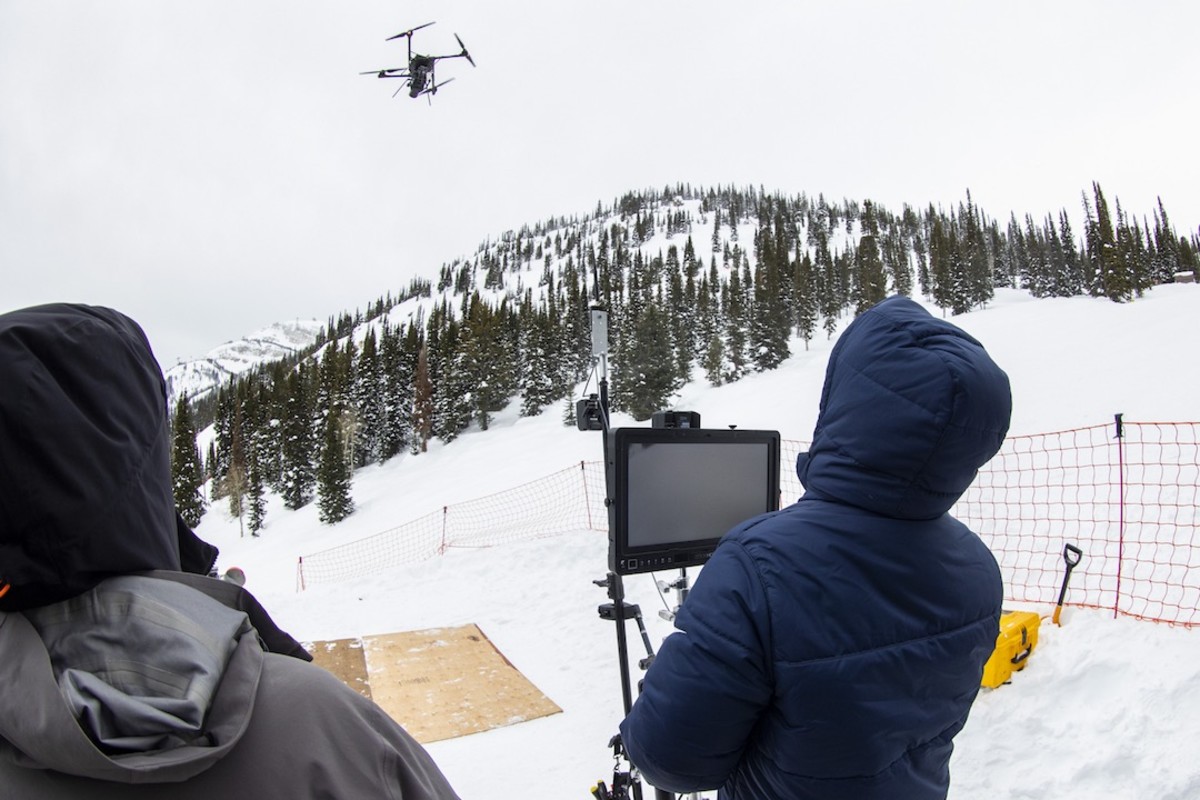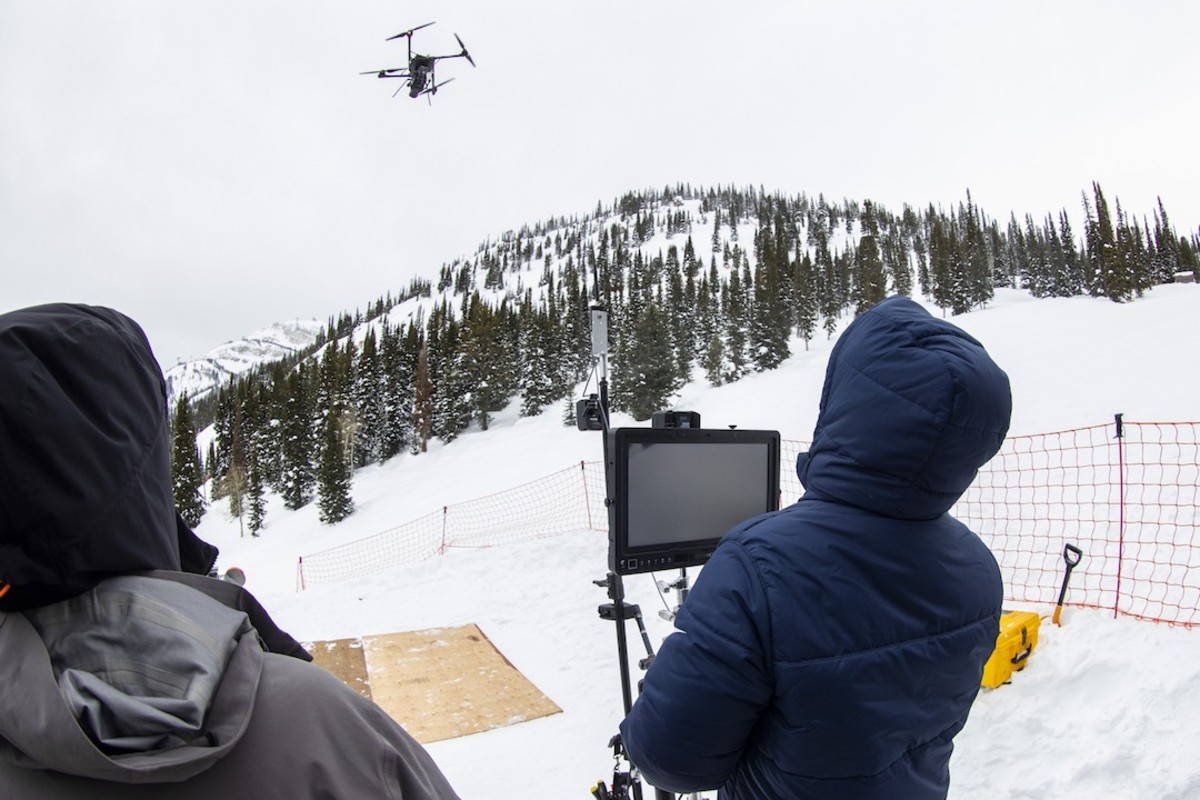
What if you could visually experience a steep, backcountry freestyle run from an elite snowboarder’s perspective? The view accounts for speed, the known and the unknown terrain below as the rider navigates through trees, the chasm across a 70-foot jump, plus that first visual of the landing after dropping blindly off a cliff. Now, what if that experience was in real-time? That was the ask for the production crew of pro snowboarder Travis Rice’s recent Natural Selection snowboard event in Jackson Hole. The solution proved to be a multi-year technological quest involving more than 100 production experts coming from every direction—live television producers to professional FPV (first-person view) drone racing pilots . All were asked to push the limits of their experience, and, oh yeah, to do it in a harsh, high-alpine winter environment with all the weather variables that holds. The result was a viewing experience that put the audience right in the action.
Within snowboarding, Rice is known as the ultimate motivator, his nickname is “Optimistic Prime,” a reference to his willingness to push himself and others to achieve extraordinary results. Rice operates with a kind of forward momentum that bulldozes through whatever obstacle stands between himself and the finish line. Chris Steblay was the point person in solving for this live, racer-POV endeavor as the Creative Director and Producer at Uncle Toad’s, a production company focused on live broadcast with roots in action sports. Steblay was up to the challenge, ready to break through what he saw as a bit of complacency in some action sports production. He says, “We took it on ourselves and our crew to just kind of go for it because the rewards outweighed the risks if we could pull it off.” Plus, he adds, “It’s Travis Rice asking, we’re all big fans. When he says, ‘This is what I want.’ Well, there’s not much wiggle room besides giving it to him. It worked out for us on this one.”
For Steblay the solution boiled down to one need: developing stabilized racing drones with a live, high-definition video feed to be used as a primary camera from the top of a mountain in the winter.

The Racing Drones
The first move was to partner with professional drone pilots who have the skills to build the fast, agile drones needed. In contrast to a traditional consumer drone, Steblay says, “Racing drones give you something like the experience of flying on the back of a bald eagle—they’re fast, quick, agile and allow you to get close to the riders, like 10 feet behind and a couple feet overhead.” The goal: to get the video game angle.
They also needed these same pilots to fly the camera-equipped drones during the snowboard competition. The tour reached out to world-champion racing drone pilot Gabriel “Gab707” Kocher. Kocher proved to be a perfect fit, the Vancouver, B.C.-based pilot happens to have a Ph.D. in physics and is also a passionate snowboarder. Kocher brought on Jordan “Jet” Temkin a fellow world-champ pilot who’s also a solid skier. The pilots participation in skiing and snowboarding was considered crucial for them to have that instinctual eye to anticipate the riders moves and speed. Rice shared, “Frankly, I don’t care how good of a drone pilot you are if you can’t anticipate the lines that these riders are taking or the way that they ride. It’s just not going to work.”
The pilots flew drones known as FPV drones, which they operate remotely using video goggles offering a first-person view. Racing drones are not sold off the shelf, they’re kits that are expertly built, balanced, engineered and tweaked by the pilots themselves. For the event, the pilots had five complete FPV racing drones ready to fly. (If you want a further taste of the cinematography potential of FPV drones, check out the recently gone-viral, single-shot short film Right Up Our Alley from pilot/filmer jaybyrdfilms)
[embedded content]
The Natural Selection race drones angles were supplemented by a pair of big-boy Freefly Alta-X drones flying higher up in the air providing a stable overhead angle. Yes, a second drone fleet.
The Camera Rig
As the pilots were designing the race drones, Steblay was focused on finding the ideal small high-def cameras to film from the drone. The cameras needed to be compatible with antennas relaying the live footage. And with that live footage, came the need to figure out how to stabilize the camera to avoid what Steblay describes as a seasickness effect (this step is usually handled in post-production). The crew added a pivoting gimbal mount for the camera—a first for a racing drone.
And finally, the antennae mount to allow the camera to transmit the footage live. Steblay brought in RF Wireless to create a 100-percent wireless event from high up on the mountain complete with receiving towers to deliver the footage straight to the live broadcast.

The End Results
The coverage was a true feat of broadcast engineering (and a new high mark for action sports coverage). The production, it should also be noted, was all done in an extreme mountain environment over a week during which the resort was hit with five feet of snow. The conditions made for not only a shovel-fest to keep the equipment (housed in flimsy ice-fishing tents high up on the mountain) visible and accessible, but also requiring a crew who were capable, aware and able to put in long hours in freezing temperatures in bonafide avalanche terrain—to say nothing of the effort put into the maintenance of keeping multitudes of drone batteries warm and charged. And yes, thought was even put into keeping the drone pilot’s hands warm, with little personal hand warmers mounted on their drone controllers. And let’s also acknowledge that despite navigating the wooded course hundreds of times throughout the two-day event oftentimes in high winds and snow, there wasn’t a single drone tree strike. Props to the skilled pilots.
A live production like this was previously only thought possible at the level of the Olympics or NFL, but the Natural Selection proved that it was possible with a scaled-back crew, in a remote environment, completely wirelessly, with Travis Rice breathing down your neck.
[embedded content]
The Natural Selection Tour Continues
Kocher will be at the remaining two Natural Selection Tour stops in Canada and Alaska, capturing these incredible video game-style camera angles, although minus the live broadcast, plus an even more remote location.
The highlight show from the Bronco Natural Selection at Baldface Lodge in Canada featuring the riders’ best lines and standout action from the week will broadcast March 19 on Red Bull TV.
The Natural Selection Tour will conclude with the super finals at The HempFusion Natural Selection at Tordrillo Mountain Lodge in Alaska from March 20-27, 2021.
For access to exclusive gear videos, celebrity interviews, and more, subscribe on YouTube!






